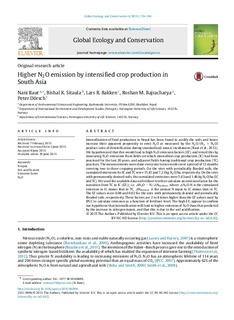| dc.contributor.author | Raut, Nani | |
| dc.contributor.author | Sitaula, Bishal K. | |
| dc.contributor.author | Bakken, Lars | |
| dc.contributor.author | Bajracharya, Roshan Man | |
| dc.contributor.author | Dörsch, Peter | |
| dc.date.accessioned | 2015-09-29T09:15:59Z | |
| dc.date.accessioned | 2015-10-09T11:49:20Z | |
| dc.date.available | 2015-09-29T09:15:59Z | |
| dc.date.available | 2015-10-09T11:49:20Z | |
| dc.date.issued | 2015 | |
| dc.identifier.citation | Global Ecology and Conservation 2015, 4:176-184 | nb_NO |
| dc.identifier.issn | 2351-9894 | |
| dc.identifier.uri | http://hdl.handle.net/11250/2353414 | |
| dc.description | - | nb_NO |
| dc.description.abstract | Intensification of food production in Nepal has been found to acidify the soils and hence increase their apparent propensity to emit N2O as measured by the N2O/(N2+N2O) product ratio of denitrification during standardized anoxic incubations (Raut et al., 2012). We hypothesized that this would lead to high N2O emission factors (EF), and tested this by measuring N2O emissions from fields on which intensified crop production (IC) had been practiced for the last 20 years, and adjacent fields having traditional crop production (TC) practices. The measurements were done every one to two weeks over a period of 12 months covering two to three cropping periods. On the sites with periodically flooded soils, the cumulated emissions for IC and TC were 15.41 and 7.23 kg N2O/ha, respectively. On the sites with permanently drained soils, the cumulated emissions were 5.43 and 1.46 kg N2O/ha (IC and TC). We used the available data on fertilizer levels to calculate an emission factor for the transition from TC to IC (EFI); i.e. View the MathML sourceΔN2O−N/ΔNfertilizer, where ΔΔN2O-N is the cumulated emission in IC minus that in TC, View the MathML sourceΔNfertilizer is the annual N input to IC minus that in TC. The EF values were 0.08 and 0.02 for the sites with permanently drained and periodically flooded soils, respectively. These factors are 2 to 8 times higher than the EF values used by IPCC to calculate emission as a function of fertilizer level. The high EFI appear to confirm our hypothesis that intensification will lead to higher emission of N2O than that predicted by the increase in nitrogen inputs, and that this is due to the soil acidification. | nb_NO |
| dc.language.iso | eng | nb_NO |
| dc.relation.uri | http://www.sciencedirect.com/science/article/pii/S2351989415000669 | |
| dc.rights | Navngivelse-Ikkekommersiell-IngenBearbeidelse 3.0 Norge | * |
| dc.rights.uri | http://creativecommons.org/licenses/by-nc-nd/3.0/no/ | * |
| dc.title | Higher N2O emission by intensified crop production in South Asia | nb_NO |
| dc.type | Journal article | nb_NO |
| dc.type | Peer reviewed | nb_NO |
| dc.date.updated | 2015-09-29T09:15:59Z | |
| dc.identifier.doi | 10.1016/j.gecco.2015.06.004 | |
| dc.identifier.cristin | 1253439 | |

